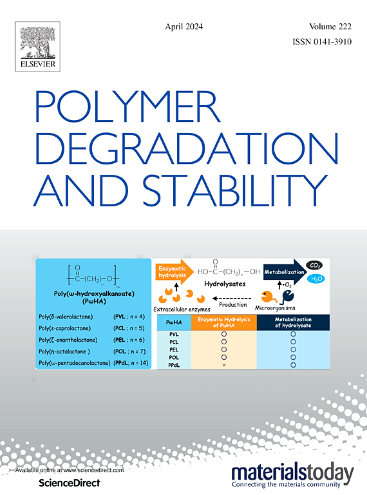Polymer-based phosphoramidite flame retardant for TPU: Enhanced fire resistance with preserved transparency and mechanical properties
IF 6.3
2区 化学
Q1 POLYMER SCIENCE
引用次数: 0
Abstract
In this work, a polymeric flame retardant (POP) containing a phosphoramidite bond was synthesized from piperazine and phenyl dichlorophosphate. The chemical structure of POP was confirmed using FTIR, TGA, DSC, 1H NMR, 31P NMR, 13C NMR and PY-GC–MS. Adding POP to TPU significantly improved its flame retardancy while maintaining its mechanical properties and transparency. Only 3 wt% of POP reduced the peak heat release rate (PHRR) of the TPU composite by 50.1 %. With increasing POP content, the PHRR and total heat release (THR) of the TPU composites decreased further, and the char residue increased. At 15 % POP, the THR and PHRR of TPU decreased by 40.7 % and 60.2 %, with char residue reaching 21.6 %. Moreover, when the amount of POP was 30 %, the TPU composite reached a LOI value of 29.2 %, passing UL 94 V-0 level. The improved flame retardancy resulted from the prior concentrated emission of CO2 in the gaseous phase and the creation of denser, more graphitized char residue within the condensed phase. Additionally, the excellent compatibility between POP and TPU ensured minimal impact on the mechanical properties and transparency. The tensile strength, elongation at break, and transmittance of TPU/15 % POP were 40.2 MPa, 525 %, and 81.5 %, nearly matching the performance of pure TPU.

求助全文
约1分钟内获得全文
求助全文
来源期刊

Polymer Degradation and Stability
化学-高分子科学
CiteScore
10.10
自引率
10.20%
发文量
325
审稿时长
23 days
期刊介绍:
Polymer Degradation and Stability deals with the degradation reactions and their control which are a major preoccupation of practitioners of the many and diverse aspects of modern polymer technology.
Deteriorative reactions occur during processing, when polymers are subjected to heat, oxygen and mechanical stress, and during the useful life of the materials when oxygen and sunlight are the most important degradative agencies. In more specialised applications, degradation may be induced by high energy radiation, ozone, atmospheric pollutants, mechanical stress, biological action, hydrolysis and many other influences. The mechanisms of these reactions and stabilisation processes must be understood if the technology and application of polymers are to continue to advance. The reporting of investigations of this kind is therefore a major function of this journal.
However there are also new developments in polymer technology in which degradation processes find positive applications. For example, photodegradable plastics are now available, the recycling of polymeric products will become increasingly important, degradation and combustion studies are involved in the definition of the fire hazards which are associated with polymeric materials and the microelectronics industry is vitally dependent upon polymer degradation in the manufacture of its circuitry. Polymer properties may also be improved by processes like curing and grafting, the chemistry of which can be closely related to that which causes physical deterioration in other circumstances.
 求助内容:
求助内容: 应助结果提醒方式:
应助结果提醒方式:


